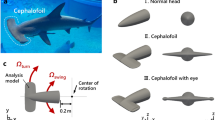Abstract
Examinations of the electrocardiogram of Pagrus major exposed to Chattonella marina, a planktonic organism causing red tide, were made to determine the physiological effects on fish. The heart rate decreased as a result of the extention in the interval between T and P waves. The decrease in heart rate with the extended intervals between T and P waves was also recognized in the condition of decreased dissolved oxygen. Also, the decrease in heart rate of the fish exposed to the red tide occurred while the fish was struggling. This reduction seems to be caused by the strong tension of the vagal nerve. Upon exposure to C. marina at high cell concentration, the heart beat at a very low frequency after 30 min. The very low heart rate is expected to limit seriously the oxygen uptake by the gill, because the cardiac output is probably very low in this situation.
Similar content being viewed by others
Literature cited
Don Stevens, E., Randall, D. J. (1967). Changes in blood pressure, heart rate and breathing rate during moderate swimming activity in rainbow trout. J. exp. Biol. 46: 307–315
Endo, M., Sakai, T., Kuroki, A. (1985). Histological and histochemical changes in the gills of the yellowtail Seriola quinqueradiata exposed to the Raphidphycean flagellate Chattonella marina. Mar. Biol. 87: 193–197
Farrell, A. P. (1984). A review of cardiac performance in the teleost heart: intrinsic and humoral regulation. Can. J. Zool. 62: 523–536
Garey, W. F. (1962). Cardiac responses of fishes in asphyxic environments. Biol. Bull. 122: 362–368
Hipkins, S. F., Smith, D. G. (1983). Cardiovascular events associated with spontaneous apnea in the Australian short-finned eel, Anguilla australis. J. exp. Zool. 227: 339–348
Holeton, G. F., Randall, D. J. (1967). Changes in blood pressure in the rainbow trout during hypoxia. J. exp. Biol. 46: 297–305
Matsusato, T., Kobayashi, H. (1974). Studies on death of fish caused by red tide. Bull. Nansei Reg. Fish. Res. Lab. 7: 43–67 (in Japanese with English abstract)
Moffitt, B. P., Crawshaw, L. I. (1983). Effects of acute temperature changes on metabolism, heart rate, and ventilation frequency in carp Cyprinus carpio L. Physiol. Zool. 56: 397–403
Nakamura, A. (1983). Remote-sensing of physiological informations in carp Cyprinus carpio. Kaiyou Kagaku. 15: 240–243 (in Japanese)
Nanba, K., Murachi, S., Kawamoto, S., Nakano, Y. (1973). Studies on electrocardiogram of fishes-I. Test of method to detect the ECG from fish. J. Fac. Fish. Anim. Husb. Hiroshima Univ. 12: 147–154 (in Japanese with English abstract)
Nomura, S., Ibaraki, T., Shirahata, S. (1969). Electrocardiogram of the rainbow trout and its radio transmission. Jap. J. vet. Sci. 31: 135–147
Nomura, S., Ibaraki, T., Hirose, H., Shirahata, S. (1972). Applications of back-pack cardiotelemeter for fishes-I. Heart rate and cardiac reflex in fishes during unrestrained swimming. Bull. Jap. Soc. scient. Fish. 38: 1105–1117 (in Japanese with English abstract)
Onoue, Y. (1987). Toxicity of red tide. In: Report on a countermeasure to red tide. Ragoshima Prefectural Fisheries Station, Kagoshima, p. 24–29 (in Japanese)
Piiper, J., Scheid, P. (1984). Model analysis of gas transfer in fish gills. In: Hoar, W. S., Randall, D. J. (eds.) Fish Physiology, Vol. 10. Academic Press, New York, p. 229–262
Randall, D. J., Daxboeck, C. (1982). Cardiovascular changes in the rainbow trout (Salmo gairdneri Richardson) during exercise. Can. J. Zool. 60: 1135–1140
Tirri, R., Ripatti, P. (1982) Inhibitory adrenergic control of heart rate of perch (Perca fluviatilis) in vitro. Comp. Biochem. Physiol. 73C: 399–402
Toyoshima, T., Ozaki, H. S., Shimada, M., Okaichi, T., Murakami, T. H. (1985). Ultrastructural alterations on chloride cells of the yellowtail Seriola quinqueradiata, following exposure to the red tide species Chattonella antiqua. Mar. Biol. 88: 101–108
Yamaguchi, K., Ogawa, K., Takeda, N., Hashimoto, K., Okaichi, T. (1981). Oxygen equilibria of hemoglobins of cultured sea fishes, with special reference to red tide-associated mass mortality of yellowtail. Bull. Jap. Soc. scient. Fish. 47: 403–409
Yamamori, K., Hanyu, I., Hibiya, T. (1971). Electrocardiography of the eel by means of underwater electrodes. Bull. Jap. Soc. scient. Fish. 37: 94–97 (in Japanese with English abstract)
Author information
Authors and Affiliations
Additional information
Communicated by M. Anraku, Tokyo
Rights and permissions
About this article
Cite this article
Endo, M., Foscarini, R. & Kuroki, A. Electrocardiogram of a marine fish, Pagrus major, exposed to red tide plankton, Chattonella marina . Marine Biology 97, 477–481 (1988). https://doi.org/10.1007/BF00391043
Accepted:
Issue Date:
DOI: https://doi.org/10.1007/BF00391043




